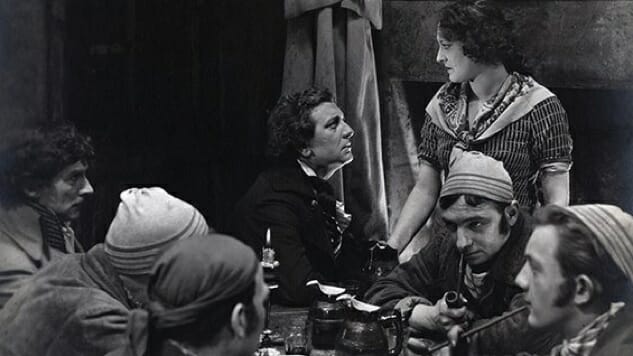Gap Year: The Red Inn (1923)
Amid catastrophe, the French Narrative Avant-Garde rewrote the screenplay.

To broaden his cinematic horizons, Ken Lowe is taking a gap year! Join him for this monthly feature throughout 2020, seeking out the essential, the classic, the weird, and the infamous films of a foreign country. This year, the spotlight is on France.
“We must look a little closer. And when we do, we see that the doughnut hole has a hole in its center. It is not a doughnut hole, but a smaller doughnut with its own hole, and our doughnut is not holed at all!”—Knives Out
It’s a familiar scene: A secluded place of deceptive comfort that shelters a group of affable strangers (or sometimes people who only believe they truly know one another) on a dark and stormy night. As the story unfolds, we know there’s more to it than what we’re being told, and we suspect that as raw and gory as the tale is, there will be some justice meted out at the end.
L’auberge Rouge (The Red Inn) has the DNA of classic mystery novels in it, and more than a little bit of the noir tales that would form a major pillar of 20th century cinema. Writer Louis Delluc and director Jean Epstein, working from a story by Balzac, tell a tale within a tale of (literal) blood and thunder, using the conventions and narrative devices of the novel, in a way that pushes the film, gently, away from the spectacular and toward the psychological.
A group of urbane and well-dressed strangers gather at a candlelit inn in 19th century France, and one of the companions tells his fellow guests a story that, an acquaintance promises, will surely make all those present shiver. On a dark and stormy night in 1799, at an inn not so different from this one, he says, another group of strangers gathered to get out of the rain. Among them are two young doctors on their way to Alsace, a fortune teller, a cheery diamond merchant, and the innkeeper’s daughter.
The diamond merchant unwisely reveals that he’s traveling with plenty of wares, blithely gifting the two doctors who kindly came to his aid in securing a place within the crowded inn with two rough diamonds of little value. The fortune teller pulls three cards that set the tone for the evening: They predict Gold, Crime and Death. The young doctor Prosper struggles with thoughts of killing the merchant and making off with his wares, but stops himself at the last moment, wailing his own mother’s name out in the rainstorm in his shame and guilt.
It’s too bad for the merchant that Prosper’s fellow traveler—our narrator has forgotten his name—does not stay his own hand. Prosper awakens to find himself covered in the merchant’s blood, the diamonds stolen, and himself implicated in the coverup. The innkeeper’s daughter, who has become infatuated with him, is devastated as the police march him off to a speedy trial and convict him, even as it seems comically clear he’s been set up. He’s killed and buried before the innkeeper’s daughter can see him one last time.
-

-

-

-

-

-

-

-

-

-

-

-

-

-

-

-

-

-

-

-

-

-

-

-

-

-

-

-

-

-

-

-

-

-

-

-

-

-

-

-








































